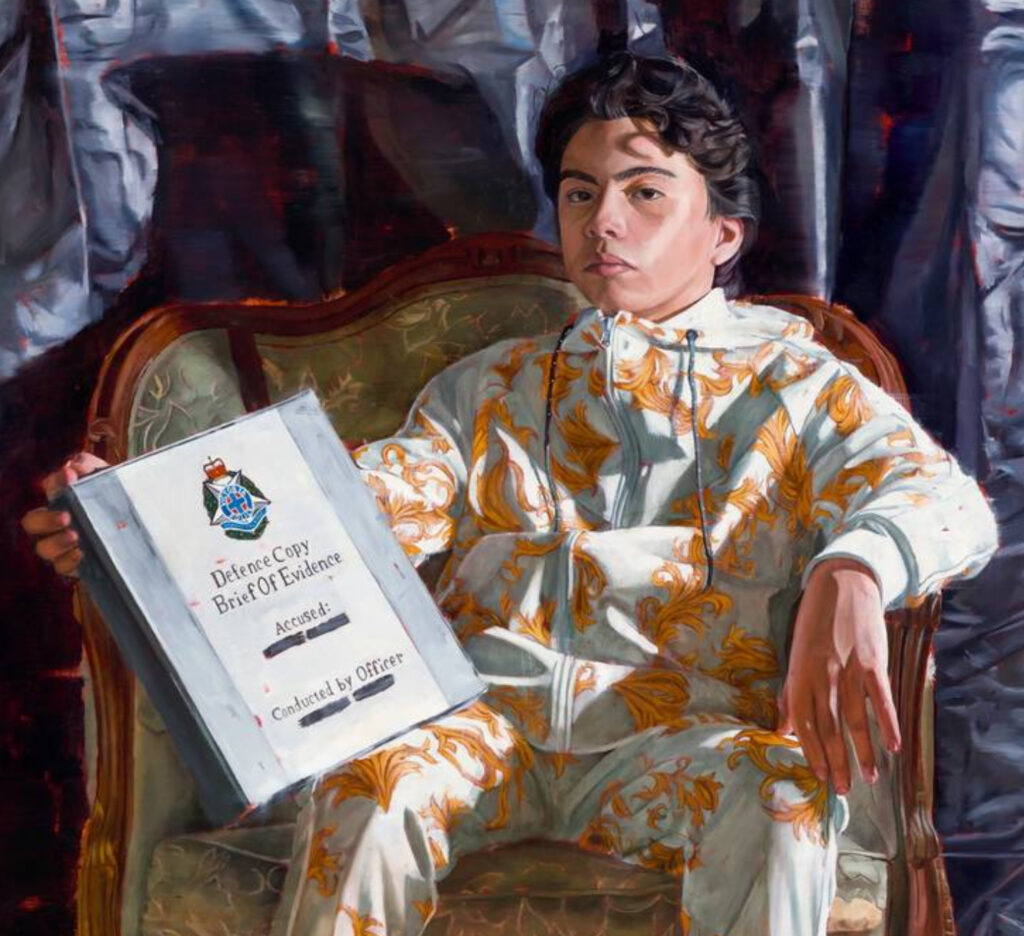Kaili Smith is an artist known for his evocative paintings that examine social constructs, urban youth culture, and the blurred lines between violence, vulnerability, crime, and reward. One of his most compelling works, Crime Prize (2020), stands as a testament to his ability to merge classical techniques with contemporary themes, presenting a nuanced reflection on societal perceptions of crime and the individuals involved in it. The painting, showcased by Victor Lope Arte Contemporaneo and listed at €11,250, has drawn significant attention for its ability to provoke thought and challenge preconceived notions.
In this essay, we will delve into the themes presented in Crime Prize, its stylistic influences, the broader context of Smith’s work, and the cultural commentary it provides. By dissecting the visual elements and conceptual foundations of the piece, we can gain a deeper appreciation for how Smith uses his art to question the societal structures that dictate morality, justice, and opportunity.
Kaili Smith’s Artistic Style: Classical Meets Contemporary
Kaili Smith’s work is often described as a fusion of classical realism and contemporary street art. He employs the techniques of the Old Masters—careful attention to light, form, and anatomy—while incorporating modern subject matter that reflects the world today. This juxtaposition allows him to create a bridge between historical artistic traditions and present-day social issues, making his work both timeless and deeply relevant.
In Crime Prize, this stylistic duality is evident. The meticulous rendering of human figures and their expressive faces echoes the techniques of Renaissance portraiture, while the urban setting, modern clothing, and contemporary themes root the painting in the present. Smith’s choice to blend these two approaches serves to highlight the ongoing nature of societal struggles—issues of crime, justice, and youth are not new, but they continue to evolve in different forms across generations.
The artist has noted in interviews that he is inspired by both classical and modern influences. He cites the works of Caravaggio and Rembrandt, particularly their use of chiaroscuro (the contrast between light and dark), as a major influence on his compositions. At the same time, he draws from graffiti culture and urban realism, ensuring that his work resonates with contemporary audiences. This combination of high art and street art sensibilities allows Crime Prize to stand at the crossroads of fine art and social commentary.
Themes of Crime and Reward
The title Crime Prize immediately introduces a paradox—two words that are usually at odds with each other. Crime is typically associated with punishment, while a prize is something earned through achievement. By juxtaposing these ideas, Smith invites viewers to consider the motivations behind criminal behavior and the ways in which society rewards or punishes individuals based on circumstances beyond their control.
One of the core themes in Crime Prize is the idea that crime is often perceived in binary terms—good versus evil, lawful versus unlawful—when, in reality, the forces that lead individuals to crime are far more complex. Economic inequality, systemic oppression, and lack of opportunity all play significant roles in pushing individuals toward crime, yet mainstream narratives often ignore these factors in favor of moral absolutism.
Smith’s painting challenges this rigid perception by humanizing his subjects. Rather than depicting criminals as faceless perpetrators, he presents them as individuals with stories, emotions, and agency. His work encourages viewers to look beyond stereotypes and consider the broader societal structures that influence crime and justice.
Violence and Vulnerability
A recurring motif in Smith’s work is the interplay between violence and vulnerability. In Crime Prize, this tension is palpable. The figures in the painting may appear strong, defiant, or even aggressive, yet there is an underlying sense of fragility. The way they are positioned, the expressions on their faces, and the body language all suggest that there is more to their story than what meets the eye.
Smith often portrays young men and women caught in situations where they are both perpetrators and victims, forced into difficult choices by circumstances beyond their control. This duality is crucial to understanding Crime Prize—it is not a glorification of crime, nor is it a condemnation. Instead, it is an exploration of the blurred lines between power and powerlessness, between survival and destruction.
By portraying his subjects in this way, Smith invites viewers to empathize rather than judge. He forces us to confront our biases and consider how societal structures contribute to cycles of crime and punishment.
A Utopia Where the Problems Are Not Fixed
Smith’s work often explores the idea of an imperfect utopia—a world where systemic issues are not magically resolved but are instead acknowledged and examined. In his exhibition A Utopia Where the Problems Are Not Fixed, he expands on the themes present in Crime Prize, including the contradictions within justice systems, the stigmatization of marginalized communities, and the impact of socioeconomic status on one’s opportunities in life.
One of the key messages in this body of work is that solutions to systemic problems require more than just surface-level fixes. Crime is often addressed through punitive measures—incarceration, stricter laws, harsher penalties—without addressing the root causes such as poverty, education disparities, and lack of social mobility. Smith’s paintings, including Crime Prize, serve as visual critiques of these band-aid solutions, encouraging deeper conversations about real change.
Interpreting Crime Prize: A Personal Perspective
As with much of Smith’s work, Crime Prize is open to interpretation. Some may see it as a depiction of defiance, a testament to resilience in the face of adversity. Others may interpret it as a critique of a society that places people in situations where crime becomes their only viable option. The beauty of Smith’s art lies in its ability to provoke multiple perspectives and encourage dialogue.
For some, the painting might evoke feelings of discomfort—a realization that the way society deals with crime is often rooted in prejudice and misinformation. For others, it might serve as a call to action, urging viewers to reconsider their stance on justice and equality.
The success of Crime Prize lies in its ability to engage viewers on an emotional and intellectual level. Rather than providing clear answers, it asks difficult questions and challenges us to think critically about the systems that shape our world.
The Lasting Impact of Crime Prize
Kaili Smith’s Crime Prize is more than just a painting—it is a statement, a challenge, and a conversation starter. By blending classical techniques with contemporary themes, Smith creates a visual language that speaks to both history and the present day. His exploration of crime, reward, violence, and vulnerability forces us to question our assumptions and confront uncomfortable truths.
In a world where discussions about crime are often reduced to headlines and statistics, Crime Prize brings the human element back into the conversation. It reminds us that behind every act of crime is a story, a person, and a series of circumstances that led them there. By encouraging empathy and deeper understanding, Smith’s work pushes us toward a more nuanced and compassionate approach to justice.
As society continues to grapple with questions of crime and punishment, works like Crime Prize serve as important reminders that there are no easy answers. Through his art, Kaili Smith challenges us to look beyond the surface and engage with the complexities that define the human experience.
No comments yet.








